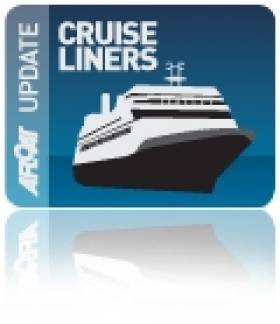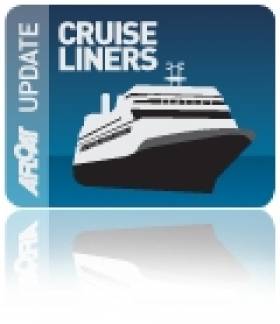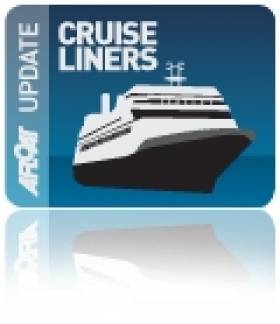Displaying items by tag: Oceania Cruises
Marshall Islands ‘Marina’ Made an Impression
#CruiseLiners -Those watching the live coverage of the recent Ocean to City rowing race would of seen the handsome Marina, a 66,000 tonnes cruiseship which had berthed in Cobh, writes Jehan Ashmore.
Only launched in 2011, Oceania Cruises 1,250 passenger capacity vessel presented a fine sight against the backdrop of Cobh in which the photograph depicts the same scene taken by our colleague, Bob Bateman, in Cork Harbour.
Marina has designer touches everywhere, from the magnificent Lalique Grand Staircase and stunning Owner's Suites furnished in Ralph Lauren Home which showcases the finest residential design and furnishings.
Of the 15 decks, there are 11 decks exclusively for guests. Among the many facilities there is an outdoor movie screen, hot tubs and basketball court and on the top deck an outdoor heated swimming pool.
As for accommodation, there are 18 inside cabins, 611 outside cabins, 591 cabins & suites with verandas and 147 suites.
Should you have missed the Marshal Islands registered cruiseship she is scheduled to visit Cork Harbour on 8 August, arriving early at Ringaskiddy Deepwater berth. Despite not berthing at Cobh, Marina will however still have to pass Cobh in both directions noting her 16.00hrs departure and where the promenade and ramparts of the town afford excellent vantage points.
In the meantime there's plenty of cruiseship callers in the preceding month, as Cork harbour is to welcome some notable cruise callers among them Princess Cruises giant Caribbean Princess (3,500 passengers) due on 1 July.
All Things Nautical As Sisters to Meet On a Journey
#CRUISESHIP SISTERS – Oceania Cruises Nautica (2000/30,277grt) currently docked in Dublin Port will later today be joined by a sister, Azamara Journey, operated by Azamara Club Cruises, writes Jehan Ashmore
Azamara Journey had departed Leith and is heading through the Irish Sea and is expected to arrive in the capital port around mid-afternoon.
Both vessels (circa 680 passengers) form part of an original eight-strong sister fleet of French built 'R' class ships ordered for Renaissance Cruises, which ceased trading in 2001, resulting in the splitting of the ships to various owners.
Incidentally Oceania Cruises also operate two more such sisters. Regatta built as R Five and Insignia, the former R1, the lead-ship of the series all having the previous owner's rather simplistic naming theme. Likewise Azamara Club Cruises operate the former R Seven, rechristened Azamara Quest.
Another 'R' class sister operating for P&O Cruises, the Adonia, which led the seven-strong spectacular sail-past in Southampton waters for the 'Grand Event' to celebrate the 175th anniversary of the famous company, is due to call to Foynes in a fortnight's time.
Noting that Adonia, led the liner line-up which included Arcadia (as previously reported), seen third in line astern and where each ship set off on separate cruises as they headed out of the Solent.
Brand New Marina Calls to Dublin
The cruise started from Copenhagen and toured several ports in Norway from where the vessel continued to Lerwick, Torshavn,Iceland, Portree and her last port of call was Belfast. The vessel had berthed in Dublin's Alexandra Basin and departed this evening bound for Dover.
Following the Marina's departure out of Dublin Bay via the North Burford bouy, was the Marco Polo. The 1965 built vessel operates for Cruise and Maritime Voyages and she proceeded past the South Burford bouy bound for St. Mary's, the capital of the Scilly Isles.
There will be many more cruisecalls such as the ultra luxury six-star Silver Cloud which is due on Sunday. The 16,927 tonnes vessel operated by Italian owned SilverSeas Cruises, has only a capacity for 294 passengers. Following that visit P&O Cruises 115,000 tonnes Azura docks in the capital this day next week to disembark up to 3,500 passengers. To view a full list of cruise callers click HERE.
The near 700-passenger capacity ship operated by UK based Voyages of Discovery is scheduled to call at several Scotish ports before returning to Portsmouth via the North Sea.
Discovery has eight decks with facilities to include two swimming pools, one with a retractable roof, jacuzzis, lounges, bars, a library and gymnasium, lecture theatre, cinema, restaurants, an internet cafe, shop, beauty salon and a medical centre.
She was built in 1971 as the Island Venture, then renamed Island Princess after purchased by Princess Cruises, alongside her sister Pacific Princess which appeared in the popular US TV series sitcom the 'Love Boat' broadcast by ABC between 1977-1986.
In total there will be four cruise-calls during the season to Douglas but the next visit will be not until July when P&O Cruises Adonia calls on the 17th. The ten-year old 710 passenger vessel is due to be named by Dame Shirley Bassey at a ceremony held in Southampton later this month.
Also calling to Douglas will be Oceania Cruises brand new 60,000 tonnes / 1,250 passenger Marina on the 24th July and the final call is to be made by Noble Caledonia's Japanese built Clipper Odyssey in mid-August.
- Killybegs
- Cork
- Discovery
- Marina
- Ringaskiddy
- Cruise Liners
- Princess Cruises
- southampton
- Isle of Man
- P&O Cruises
- Ports and Shipping News
- Manx
- Voyages of Discovery
- Douglas
- Douglas Bay
- Adonia
- Dame Shirley Bassey
- The 'Love Boat'
- ABC
- Pacific Princess
- Island Princess
- Oceania Cruises
- Cruise Liner news
- Clipper Oydessey
- Noble Caledonia
































































